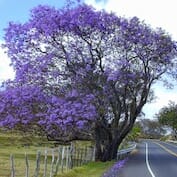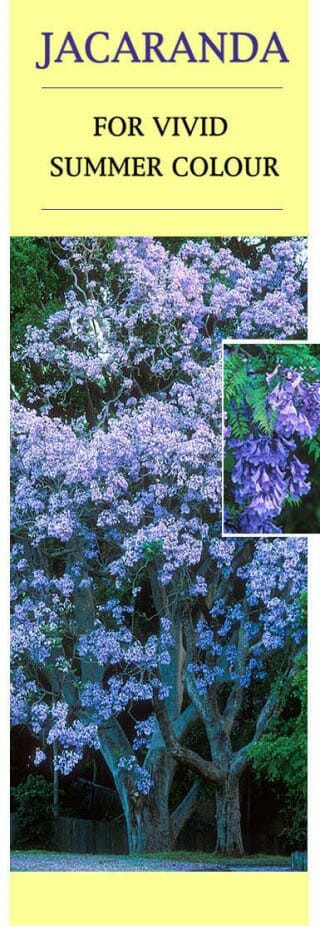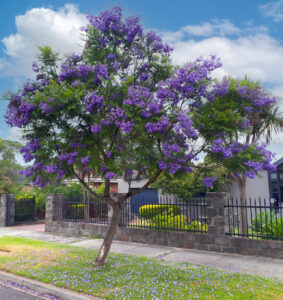The Jacaranda tree puts on a breathtaking floral display. Its vivid lilac-blue clusters of trumpet shaped blossoms appear in the summer, later falling to the earth carpeting the ground with a mass of color.
It is said that if you are walking underneath the Jacaranda tree and one of the trumpet blossoms falls on your head you will be favored by fortune.
Jacarandas are used world wide as a decorative ornamental tree commonly used to line avenues. Their history and significance has been extensively documented from the famous annual Grafton festival in Australia to Pretoria, The Jacaranda City, (located 50 kms north of Johannesburg) noted for it’s 70,000 plus flowering Jacaranda trees. Jacarandas have richly figured timber that is rarely cut, as it’s ornamental value is high. The interesting leathery seedpods follow flowering.
A LOVELY SPECIMEN TREE
Jacaranda mimosifolia is the most widely planted and admired tree of the Jacaranda family, which consists of more than fifty species.
J. mimosifolia is a fast growing tree that thrives in fertile, well-drained sunny positions, they don’t like heavy wet soils. Young plants require some protection from frost in their first year, if the tops blacken off simply prune them and new shoots will sprout. Jacarandas are a shallow rooted tree and are excellent for use as ornamentals in large to smaller sized gardens, growing 10m high by 10 m wide. J. mimosifolia is recommended for street and park plantings and garden situations where light summer shade is required. In Australia gardens from Melbourne to Cairns the Jacaranda tree creates the perfect summer centerpiece. It erupts in a blaze of brilliant color when most spring blossom trees are long gone.
EXOTIC HERITAGE
The Jacaranda tree is striking when it’s lilac-blue floral show dominates the landscape, December in Melbourne. Many people believe this tree to be native to Australia but its origin is Brazil and other parts of tropical and sub-tropical South America.
It is naturally found in the high and dry deserts of Brazil thus in Melbourne after a dryer year floral displays are better. In Rio the Brazilians pronounce Jacaranda as hakharanda. J. mimosifolia puts on a floral show twice a year the first blooms appearing as 20cm long floral clusters when its branches are bare with the second flush in the summer once the lush green leaves have emerged.
Jacarandas are fast-growing trees with soft graceful fern-like foliage. The Jacaranda is a deciduous tree forming a rounded crown, and they respond well to pruning but tall vertical shoots may grow from these cuts detracting from their natural ornate shape. Jacarandas will shed their leaves during the winter often turning rich yellow before falling, in cooler areas.
CLIMATIC REQUIREMENTS
Jacarandas prefer a warm coastal climate that is frost-free or where light frost occurs. J. mimosifolia will grow well in the suburbs of Melbourne where the average rainfall exceeds about 650mm. Planted in pots and gardens Jacarandas should be watered freely in the warmer months.













